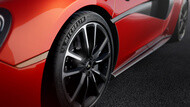
Tips & Advice for Car, SUV & Van tires
Having the correct recommended tire pressure in your vehicle’s tires not only optimises the performance but also increases your personal safety and those of other road users when driving.
On the other hand, incorrect tire pressure will reduce the grip of your tires and increase your braking distances. It can also damage your tires, reduce their life span and increase your fuel consumption. Let's take a look at how to avoid these risks and what tire pressure is needed for your vehicle.
What pressure for your tires?
Checking your tire pressure is simple and inexpensive. It is important to use the pressure recommended by the manufacturer to avoid overinflation or under-inflation.
- Overinflation can lead to premature tire wear in the centre of the tread.
- Under-inflation can lead to premature tire wear in the shoulder area. It reduces the grip qualities.
The tire pressure recommended by your manufacturer
The pressure has been optimally defined by the manufacturer for the vehicle / tire combination. All performances have been checked by the manufacturer with a clear objective: your safety. This is why it is imperative to consult the pressure recommended by your manufacturer for your vehicle. It is generally indicated:
- on a sticker in your driver's side door,
- in the fuel filler flap,
- or in the vehicle manual.
The recommended pressure for your front and rear tires may not be the same. You will also see that two types of pressure are indicated:
- Normalized pressure: this is the standard pressure
- Loaded pressure: to be adopted when the vehicle is particularly loaded, for example when going on holiday
The pressure is indicated in the pressure unit used in the country you live in: in BAR or in PSI (1 bar = 14.50 psi).

The risks of incorrect tire pressure
The manufacturer's recommendations are essential for your safety and you should refer to them whenever you check the pressure of your tires. Otherwise their performance may be reduced, especially in the following cases:
Endurance
Driving on underinflated tires causes deterioration of the overall tire structure which can lead to dislocation and/or bursting.
Aquaplaning
If below the vehicle manufacturers recommended tire pressure, there is a sharp increase in the risk of aquaplaning.
Braking
A difference of 1 bar or 14 psi, from the vehicle manufacturers pressure recommendation can increase the braking distance on wet roads by 11 metres.
Fuel Consumption
Tires under inflated by 14 psi (1 bar) have increased rolling resistance, which increases fuel consumption by 1 full tank of fuel per year.
Correct tire pressure: a safe, economical and responsible move
A tire inflated to the recommended tire pressure improves safety, is more economical in use, and is better for the environment.
And since a tire loses some of its pressure through natural causes (typically around 0,07 bars per month), regular checking is necessary.
If your vehicle was manufactured after 2014, it should be equipped with a TPMS (Tire Pressure Monitoring System) that alerts you when your tires are under-inflated. However, it is recommended that you do not wait for this signal to worry about the correct pressure of your tires.




